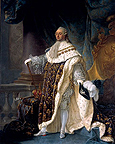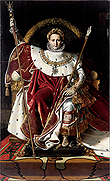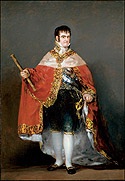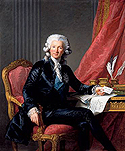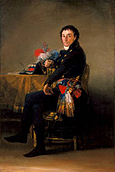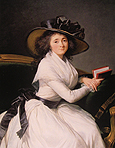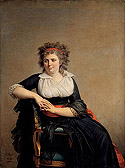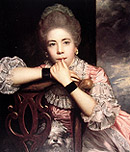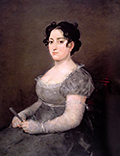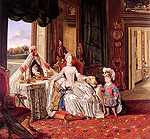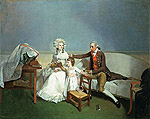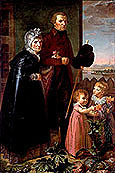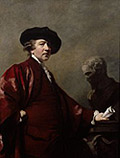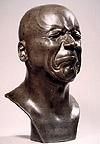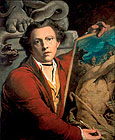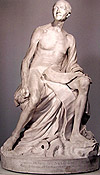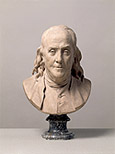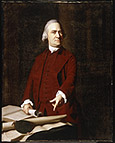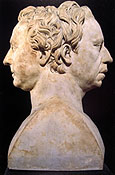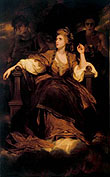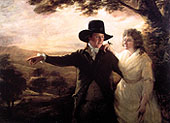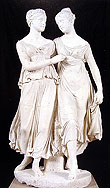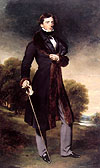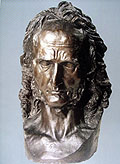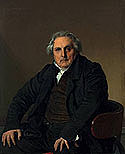The browser will either open the file, download it, or display a dialog.
|
Portraits publics, portraits privés : 1770–1830
Portraits publics, portraits privés : 1770–1830
Citizens and Kings: Portraits in the Age of Revolution 1760–1830 |
|||||
|
At one point in his brilliant study Goya, the Origins of the Modern Temper in Art, Fred Licht perceptively remarked: "A comprehensive study of European portraiture from 1780 to 1828 is still lacking in the literature of art history. But it is unquestionably at this time that the changing position of man in his world and his own esteem was made most graphically clear by changing attitudes in the field of portraiture."1 A quarter of a century later, this major lacuna has finally been filled by an ambitious Grand Palais exhibition that fully justifies Professor Licht's singling out of the art of portraiture for its uniquely privileged interpretative role with respect to these years of great social and political upheaval. | |||||
| Portraits publics, portraits privés: 1770–1830 (entitled Citizens and Kings: Portraits in the Age of Revolution in its London venue) is something of a sequel to a legendary exhibition held at the Grand Palais in 1974, De David à Delacroix (French Painting 1774–1830: The Age of Revolution). Although the time frame remains the same, the present exhibition has been both narrowed to a consideration of portraiture only, and broadened to include painting and sculpture from a dozen different schools of European and American art. Unlike De David à Delacroix, "Portraits" is not organized chronologically, but by theme. And, it should be said from the outset, many of the most revealing moments in this complex exhibition are achieved through the ingenious juxtapositions of works of art that have either been directly proposed by, or at least inspired by, the exhibition's principal curator, the much–missed Robert Rosenblum, who died a few months after the opening at the Grand Palais. Professor Rosenblum was one of the organizers of De David à Delacroix, and "Portraits", coming some thirty years later, seems an appropriate conclusion to at least one of the many life-long, modernist, art historical projects he pursued during his distinguished career. Indeed, the two exhibitions summarize a trajectory leading from Rosenblum's pioneering efforts to reassess French painting of the late-eighteenth and early-nineteenth centuries, to the influential role he played in championing artists of neglected schools of nineteenth-century painting. The Grand Palais exhibition feels at times like a tribute to Professor Rosenblum, and it is hard to imagine a more fitting one, though if he were here Bob would undoubtedly protest any such claim with a flash of his inimitable, self-deprecating wit. | ||||||
| "Portraits" was organized jointly by the Louvre, the Royal Academy of London and the Guggenheim Museum in New York.2 Each of the curators involved clearly has his own parti pris, and at times the exhibition suffers from this organizational structure. In the end, however, all remain essentially committed to the exhibition's stated goal: to explore in what manner and with what invention the portrait painters and sculptors of the Age of Revolution gave artistic expression not only to the collapse of the ancien régime, but also to the tensions that developed between man's assertion of his individuality and his fervent adherence to new ideals. (Avant–propos, n.p.). | ||||||
| The opening section of the Grand Palais exhibition, entitled "The Attributes of Power," begins with heads of state and church: kings, emperors, presidents and popes. In Antoine-François Callet's Louis XVI we find an unquestioning continuation of the grand tradition (fig. 1). The portrait invokes models from the Age of Absolutism—in particular Rigaud's celebrated portrait of Louis XIV—where majestic robes, crowns, scepters, decorations, thrones, columns and draperies all speak of the king's exalted state, and confirm his place at the head of a divinely ordained, universal order. For his portrait of the great hero of the American Revolution and first president of the victorious new republic across the Atlantic, Gilbert Stuart revised baroque prototypes rather than reject them outright (c. 1800, New York Public Library). Washington stands before the familiar pair of classical columns and heavy, billowing curtains, but the royal throne has been replaced by a desk chair adorned with a miniature flag of the thirteen colonies, a copy of the U.S. Constitution has taken the place of crown and scepter, and the president is depicted soberly dressed in black without decorations. With David's 1812 portrait of Napoleon (Washington, National Gallery of Art), we witness a complete modernization of the French absolutist model. Rather than being apotheosized, Napoleon is portrayed as a modern head of state and legislator hard at work in his study. David has pictured Napoleon standing squarely in the center of a tightly constructed architectural composition that further focuses our attention on the statesman through the introduction of space concentrating, perspective orthogonals. The code civil is spread out on the desk, the candles are low, it is four o'clock in the morning, and the progressive emperor is still laboring for his people in a tireless effort to consolidate a new moral order based on written laws—an order of which he is at once the creator and the embodiment, a perfect illustration of the exhibition's fundamental premise. David's innovative portrait of Napoleon, which was to become a prototype for future presidents of France, makes Ingres' gloriously improbable imperial allegory of 1806 hanging at its side, seem all the more fantastic and remote (fig. 2). | ||||||
| Soon after Napoleon's final demise, Goya launched a venomous attack on the restored Spanish Bourbon king, Ferdinand VII, in a portrait that goes far beyond his earlier cynical, ironic portraits of Ferdinand's father Charles IV (fig. 3). Now, after years of brutal Napoleonic occupation, Goya shows even greater disdain for the hopelessly bankrupt institution of the Spanish monarchy. Surrounded by dead, empty space and stripped of the time-honored attributes of power, Ferdinand stands in his ill–fitting robe, his hand clasping the arm of an absent throne, the ridiculous image of an exposed sham, a grotesque, idiotic marionette. | ||||||
| Most later-eighteenth-century and early-nineteenth-century portrait painters and sculptors customarily subordinate concerns with rendering an individual's unique physiognomy and character to the greater imperative of conveying their sitter's elevated social rank. These so-called status portraits, which include the majority of the portraits executed during our period, establish a client's precise standing in the overall social hierarchy through a codification of costume, pose, gesture and expression as well as surroundings, furnishings and accessories. In the next room of the exhibition, Vigée-Lebrun's portrait of Charles-Alexandre de Calonne, the minister of finance under Louis XVI, is especially notable for its careful observance of these conventions (fig. 4). The elegant French minister sits perfectly poised before a gray pilastered wall and plush red satin curtain, his lofty estate, as well as his subservience to a higher authority, clearly signaled by the Order of the Saint-Esprit decoration he wears on his breast, and the letter addressed to the king he holds conspicuously in his hand. With one exception, all the portraits in the room conform to this tradition and portray proud, dignified men in the exalting service of their prince, king, emperor or country. Only Goya's portrait of the French Republican ambassador to Spain, Ferdinand Guillemardet, violates the codes associated with the status portrait (fig. 5). Although Guillemardet wears the official uniform of a Republican ambassador, he makes a surprisingly vulgar show of his tricolored sash and plumed hat. The French diplomat's pose, moreover, is far from stately: casually seated at a table without any distinguishing props, Guillemardet, his legs crossed and his left arm impudently turned out toward the viewer, projects a vaguely threatening air of Gallic superiority, self-importance and precipitateness. Indeed, for all his self-assertion, the French ambassador strikes us as being as unworthy, as devoid of grandeur, dignity and nobility as Goya's Spanish monarchs. Consequently, Goya's Guillemardet should be interpreted as more than a sharply critical study of an individual identity, carried out at the expense of the sitter's eminent diplomatic status. Exactly contemporary with his Family of Charles IV (1798, Prado), Goya's portrayal of the Republican ambassador reveals the flip side of the artist's skeptical realism: for if the ancien régime has been definitively discredited, then its replacement by a revolutionary new order demanding man's disciplined and selfless allegiance to an abstract legal authority, has in turn proved to be illusory. Goya's Guillemardet is not only at odds with the status portrait, but it is also singularly un-Davidian, even anti-Davidian. Even before witnessing the horrors of Napoleon's Iberian campaign (1808), Goya seems not to have shared the general enthusiasm for the French Revolution. And he must not have believed, as did David, that the French were succeeding in the creation of a democratic, egalitarian republic. For Goya the French Revolution had above all occasioned the release of a tremendous amount of individual energy, and his portrait of Guillemardet is an ironic critique of the Revolution's inevitable degeneration into a theater of unprecedented opportunity—one where freshly liberated men rashly pursued selfish ambitions in their quests for adventure, personal glory and social advancement. Guillemardet, an unknown physician who became the French ambassador to Spain, is a perfect exemplar of a new social type, the Republican arriviste. Throughout the first part of the exhibition one of the principal sources of tension will be the growing opposition that develops between David and Goya and the extreme positions informing their respective conceptions of the art of portraiture: David's rationalist absolutism, first as a militant Republican, then as a zealous Bonapartist, and Goya's pessimistic realism born of a profound disillusionment with the Age of Revolution and the phenomenon of individualism. | ||||||
| In the next section, "Portraits of Women," the visual dialogue among paintings becomes more diverse with the addition of important new voices. Again, Mme Vigée-Lebrun provides the quintessential status portrait with her ravishing portrayal of the comtesse de la Châtre (fig. 6). A prominent French aristocrat and member of the court on the eve of the Revolution, the fashionable countess, wearing a fine white muslin dress and splendidly beribboned straw hat, sits gracefully posed on a canapé reading the latest novel. Painted a year later, in 1790, David's austere portrait of Robertine Tourteau hangs to one side of Vigée-Lebrun's stylish lady of quality at leisure (fig. 7). Though David's sitter is the daughter of a rich banker, he is fundamentally indifferent to her social rank, and works instead to transfigure Mme Torteau into his ideal of modern womanhood: the French Republican citoyenne. Imposing, reserved and purposeful, Mme Torteau is dressed in black and white with vivid red accents struck by her head band and sash. Her moral rectitude and firmness of resolve are eloquently communicated by the composition's straight lines and simple geometrical forms, a correction of the frivolous cursive lines of Vigée-Lebrun's Louis XV canapé and the fluent arabesque of the countess' handsome, supple figure. On the opposite wall are English ideals of modern woman in sumptuous, aristocratic portraits that honor, however grandiloquently, nature's essential role in the moral education of the female sensibility. Portraits of women in natural settings is a major late-eighteenth and early-nineteenth-century genre and there are several excellent prototypes in the exhibition, in particular Reynolds' magnificent portrait of the Montgomery sisters (1773, Tate); but this British fashion also produced amusing variants like Reynolds' tongue-in-cheek portrait of the redoubtable countess of Bute (1777–9, Mount Stuart, Private Collection) taking her daily constitutional, parasol firmly in hand in the unlikely event of a bright spell. | ||||||
| Part of the room is devoted to the dubious class of women performing artists, who tended to lead not so private lives that scandalously breached codes of period female comportment. Gainsborough's full-length portrait of the Italian ballet dancer and demimondaine Giovanna Baccelli (1782, Tate) offers a further twist on the vogue for painting grand ladies in natural surroundings. Depicted in the leading role of "Les Amants surprise," Baccelli lifts her skirts and displays a fine foot and bare ankle as she dances before a painted theater backdrop—a fictive landscape—a fitting setting for the ballerina's own fictive virtue. Similarly, Reynolds portrays the beautiful former prostitute turned actress Miss Abington in the guise of Miss Prue, her signature role from Congreve's Restoration comedy Love for Love (fig. 8). But Reynolds creates a degree of ambiguity by adopting a specific, exceptionally close viewpoint that deflects our attention from what may or may not be the setting for Congreve's play, to the piquant little actress herself. Turned nonchalantly around in her chair and staring the (male) viewer shamelessly in the eye, her thumb pressed to her lip in a suggestive vulgar gesture, Miss Abington is at once mesmerizing, provocative and irresistible. Reynolds is himself clearly under the spell of his sitter, and he wittily contrives to seduce the viewer and metamorphose him into an ardent, fellow suitor. There is a dramatic change of mood as we move to the final picture in the series of performing female artists, Goya's portrait of the singer Lorenza Correa (fig. 9). Seated off stage and robbed of the accessories and furnishings that would affirm her glamorous artistic status, Goya's stiff, self-conscious singer seems to be suffering from the same stage fright she likely experiences before her public. As so often in his portraits, Goya's relentless focus on an individual identity reveals the isolation and insignificance, the inadequate humanity of a sitter that fails to elicit either the viewer's respect or sympathy. | ||||||
| In the company of Goya and David, British portraitists may come off as bland, uncritical and insufficiently exigent, but it is their very inclination to indulgence, good-humouredness and affability that recommends their portraits to us. These same qualities are to be found in the English family portraits shown in the next section of the exhibition. In the second half of the eighteenth century, the traditionally strict hierarchic order within the family was relaxed, and the urge to create a new ambience of mutual respect, affection and intimacy among family members arose, and became more pronounced with the passage of time. In the exhibition, the emergence of new family ideals of sociability and domesticity is explored in group portraits executed on both sides of the Channel, but the phenomenon is persuasively demonstrated only in the case of the British school. Zoffany's Portrait of Queen Charlotte and her two eldest sons and Reynold's Braddyll Family (1789, Fitzwilliam Museum) are fine examples in which the members of each family are further bound to one another by their shared affection for a beloved dog (fig. 10). Henry Walton's conversation piece, Sir Robert and Lady Buxton with their daughter Anne is an enchantingly staged scene of a loving couple engaged in the education of their young daughter (fig. 11). The continental family portraits are something of a hodgepodge that includes Napoleonic dynastic portraits, an anonymous primitive of a French bourgeois family and a fascinating moralizing allegory by Runge (fig. 12). Runge's strangely symbolic, meticulously painted portrait of his elderly parents guiding his two small children through life's perilous quest for spiritual betterment, is a welcome addition to the exhibition; but a more relevant and potent foil for the ingratiating English conversation pieces might have been a group portrait by Goya, like the Family of the Duke of Ozun (Prado), where we search in vain for a hint of intimacy or congeniality among the duke's vacant and remote family members, each of whom appears frozen in his own empty solitude. | ||||||
| During these same years, a keen new interest in children and the nature of childhood, as a world distinctly apart from that inhabited by adults, prompted the rapid growth of children's portraits. The French sculptor Jean-Antoine Houdon made a specialty of this genre, modeling captivating busts of his own children, as well as those of close friends. Houdon's adorable, exquisitely carved marble bust of his daughter Sabine at ten months is a perfect model of childhood innocence, delicately individualized by intimations of the child's somewhat pensive character (1788, Metropolitan). | ||||||
| On the other hand, innocence would hardly be the word that would come to mind standing before the deeply unsettling portraits of two monstrous children hanging nearby. In Goya's celebrated portrait of Manuel Osorio Manrique de Zuniga (1788, Metropolitan), the expressionless, doll-like, young don cruelly walks his pet magpie on a leash before a group of crouching, eye-bulging cats. No less disturbing is Géricault's portrait of Louise Vernet as a perverse little temptress (c. 1818, Louvre). With her dress pulled off one shoulder and hiked above a knee, Géricault's woman-child holds a cat symbolically in her lap and stares knowingly at the viewer with a wanton "come-hither" look. The effect of seeing these two portraits together is something of a shock, and they may well constitute the period's most willful efforts to subvert prevailing standards of childhood behavior. | ||||||
| Entering the small room entitled "The Portrait of the Artist," one is immediately drawn to the deeply affecting self-portrait bust by Jean-Baptiste Pigalle (fig. 13). Pigalle was the sculptor of a major royal monument commissioned by Louis XV for the city of Reims, but when he modeled his own likeness he was thoroughly unconcerned with his grand, official position. In the words of curator Guilhem Scherf, the bust "is simply the image of an extenuated man, prematurely aged, and that in itself is very moving" (p. 188). One need only compare Pigalle's terracotta with Reynold's vainglorious self-portrait as academician—wearing a Rembrandtesque beret and standing before a portrait bust of the brooding Michelangelo—to realize how exceptional Pigalle was in his preference for truthfulness, integrity and veracity (fig. 14). | ||||||
| The room of artists' portraits also includes some curious experiments illustrating the protean image of the modern artist. The most startling of these works is the Louvre's recently-acquired bust by the eccentric Austrian sculptor Franz-Xaver Messerschmidt (fig. 15). Listed as a character study, "man of bad humor," in a 1793 exhibition, the lead bust is one of a large series of bizarre, grimacing heads that has no equivalent in the history of occidental sculpture. In reality, as the exhibition catalogue informs us, the busts are all self-portraits recording the deranged artist's extraordinary attempts to exorcise malign spirits from his tormented body and soul. The theme of persecution also haunts the Irish history painter James Barry's allegorical self-portrait as Timanthes, an ancient Greek painter reputed for the superior invention of his art (fig. 16). Barry portrays himself holding a painting of Cyclops and the Satyrs—described by Pliny in his biography of Timanthes—before the base of a statue of Hercules crushing the serpent of Envy. The Irish painter, who was pathologically convinced that his career had been poisoned from the beginning by jealous colleagues and critics, pictures himself making a desperate plea for the viewer's sympathy, as the still-threatening serpent bares its fangs and prepares to strike the hapless, unsuspecting painter. | ||||||
| The broad-ranging exhibition continues on the upper floor with a survey entitled "The Search for the Ideal." Climbing the stairway to the second floor of the Grand Palais, the visitor is greeted on the landing by Pigalle's spectacularly installed and lighted nude statue of Voltaire (fig. 17). Pigalle's triumphant masterpiece, which as Voltaire himself recognized was a potent symbolic monument celebrating the freedom of thought, appropriately introduces the next section of the exhibition, "The Cultural Portrait." Throughout the exhibition's galleries, the curators have displayed numerous later eighteenth century busts that are superlatively representative of this important genre of portraiture, designed not only to honor the individual memories of the brilliant writers, thinkers and scientists of the Enlightenment, but also to capture the spirit of their age with its noble ideals of reason and truth, liberty, justice and tolerance. Particularly fine examples exhibited include, in addition to Pigalle's self-portrait, Augustin Pajou's portrait of the architect Charles de Wailly (1789, Lille), Houdon's busts of Franklin, Diderot (1780, Langres), the mathematician Condorcet (1785, Philadelphia, American Philosophical Society) and the bibliophile Méjanes (1786, Aix-en-Provence, Bibliothèque Méjanes), and finally the unexpected bust of Catherine the Great as enlightened sovereign by the Russian sculptor Fedot Ivanovich Shubin (figs. 18, 19). Unfortunately these busts, when shown in vast rooms of full-length painted portraits, even if instructively paired with more conventional status portraits, rarely make a proper impact or attract the attention they deserve. It would have been both more effective and made more sense didactically to group these portraits in the room immediately following Pigalle's Voltaire. Instead, the room in question is turned over to rather poor quality, inexpensive plaster and terracotta statuettes of the grands hommes, which were executed in large numbers to diffuse further the edifying example of the celebrated philosophes and savants of the time. The display is informative, but again to this reviewer's mind the space would have been put to better use with an exhibition of major portrait busts demonstrating the great subtlety and consummate skill with which the sculptors of the Enlightenment arrive at the thoughtful, inquiring and above all honest expressions, the informal, engaged poses, and the relaxed, open-necked dress that distinguish their remarkably individualized portraits, and convey so effectively the worthy ideals shared by their illustrious, broad-minded sitters. | ||||||
| This hypothetical room would also have been a more telling foil for the subsequent room where we witness the corruption of Enlightenment ideals through the advent of French Revolutionary Wars and Republican martyrs, the cult of Napoleon and the return of the Bourbon kings. Entitled "History Incarnate," this section exhibits portraits that also function as modern history paintings. Predictably we find David's Napoleon Crossing the Alps (1800, Château de Malmaison) and The Death of Marat (a replica, Louvre). Guerin's royalist portrait of Henri de la Rochejaquelein (1817, Cholet), the young Vendée general killed in battle at the age of twenty-two by Republican soldiers is much less familiar. But surprisingly, the most compelling painting here is Copley's portrait of the American patriot Samuel Adams commissioned immediately following the Boston Massacre of 1770 (fig. 20). Using dramatic lighting to heighten the scene's momentous aura, Copley represents Adams standing before a table covered with official documents, emphatically pointing to the charter of the Massachusetts Bay Colony with one hand, and holding a petition protesting the Boston Massacre and demanding the withdrawal of British troops in the other. After the grandiose, idealized heroics of the Davidian historical portraits, there is something oddly touching about the plain-spoken, unpolished manner and the grim determination of Copley's impassioned colonist—a courageous, simple man, we finally realize, acting in the true spirit of the Enlightenment. Indeed, Copley's portrait serves as a timely reminder that it is this spirit with which we still—or should still—most closely identify today. | ||||||
| By the year 1800, neoclassicism had evolved into a pan–European plastic language shared by all artists, but perhaps first and foremost by the sculptors of the time. In the next room, "The Portrait 'all'antica,'" neoclassical portrait sculpture is examined through an all but overwhelming array of busts by Italian, French, English, Scottish, German and Danish sculptors, most of whom had studied in Rome, and made the ancient Roman portrait bust their essential point of reference. Drawing from a vast fund of antique sculptural forms and styles, these international sculptors searched for the prototype best suited to the physiognomy and sensibility of their sitters—the one that would, when needed, lend the desired historical dimension and grandeur to the subject's public image (pp. 256–9). Of all forms the herm enjoyed the greatest favor, and its revival led to a wide range of experimentation. The herm bust is represented in the exhibition most notably by a curious back-to-back double portrait of José-Nicolas de Azara and the painter and theorist Anton Raphael Mengs (fig. 21), a severe, powerful bust of the French abolitionist the Abbé Raynal (1790, Saint-Geniez-d'Olt, Mairie), Johann Gottfried Schadow's sensitive portrayal of the young German architect Frederich Gilly (1801, Berlin, Archiv du Akademie der Künste), and Christian Daniel Rauch's beautiful and solemn bust of Queen Louisa of Prussia in the guise of the Ludovisi Juno (1805, Stiftung Preussiche Schlösser und Gärten Berlin-Brandenburg). The highpoint of this survey is undoubtedly the series of three busts by Joseph Nollekens of the political radical Charles James Fox. The progressively archaizing sequence begins with a dashing baroque portrait of the radical Whig (1791, private collection), moves on to a much sobered, short haired and toga-clad Fox, resembling an early Roman dignitary (1802, Victoria & Albert Museum), and ends with an austere bare-torso bust that evokes the spirit of the great orators of ancient Greece and Rome (1805, London, National Portrait Gallery)—each portrait, according to Malcolm Baker, finding "a balance between Fox's individual appearance and the paragon expected in a public image of a political personage" (p. 265). | ||||||
|
The section, "Allegorical Portraits," is intended to function as a female counterpart to the earlier section of virile, historical portraits. Reynolds and Canova dominate the genre during the late eighteenth and early nineteenth century, and not unexpectedly the works selected for this room are overshadowed by the presence of two monumental Greek muses: Reynold's Sarah Siddons as the Tragic Muse and Canova's Alexandrine de Bleschamp as Terpsichore, the muse of dance and lyric poetry (1811, Parma, Fondation Magnini-Rocca) (fig. 22). The two artists, however, have fundamentally divergent approaches to the problem of the allegorical portrait. Reynolds completely assimilates his Michelangelesque sources from the Sistine ceiling, and successfully adapts them to a new design and purpose: in a sublime evocation that raises the art of portraiture to the level of grand history painting, the great tragedienne nevertheless remains an immediately recognizable historic personage. Canova's priorities lay elsewhere. The model for Canova's resplendent, harmonious composition is the wife of Lucien Bonaporte, the lyrical poetess Alexandrine de Bleschamp. Although the celebrated French beauty is recorded as having actually posed for the bust of Terpsichore, in the end she inspired a portrait of such exceptional classical ideality that when the marble was exhibited in the Salon of 1812, critics were unable to recognize any traits of the wife of the Emperor's brother and concluded that Canova had changed the final subject of his statue. | |||||
| In the next room, one of the more original, if minor themes of the exhibition, "Nature and Grace" expands on an earlier examination of nature's salutary influence on the female sensibility. Over and above effecting a return to a simpler, purer state of nature, a prolonged communion with nature was believed to engender an outward physical grace, an unforced, easy and flowing grace in accord with nature's own gently undulating rhythms. Three major paintings presented in the exhibition convincingly illustrate this period notion of natural grace: Wright of Derby's celebrated Brooke Boothby (1781, Tate Britain)—Rousseau's English publisher—pictured gracefully, if foppishly, disposed along the bank of a gently cascading woodland stream; Raeburn's intimate, tender double portrait of Sir John and Lady Clerk admiring the rolling landscape of their Scottish estates (fig. 23); and Prudhon's portrait of the Empress Josephine in the park at Malmaison (1805–9, Louvre), where wild flowers allude to her fondness for botany and the undulations of her contours harmonize with those of the surrounding boulders. The search for a more natural gracefulness has a sculptural equivalent in the moderated neoclassical art of Lorenzo Bartolini, who consciously undertook a revision of the systematic, linear stylizations and chilly, archaizing grace associated with the sculpture of his famed older contemporary Canova. In his group of Emma and Julia Campbell, Bartolini choreographs the Scottish sisters in a graceful, unaffected little dance that unfolds in three-dimensional space, rather than remain plane-bound in the manner of Canova's more artificial dancers (fig. 24). To this same purpose, Bartolini has individualized his models' features, and alternated idealized passages of sculptural modeling with more naturalistically rendered ones; but it is above all the human warmth, the youthful feminine charm and the natural sisterly affection conveyed by the fluent gestures and attitudes of Bartolini's ingratiating composition that pose a direct challenge to Canova's remote, exquisitely mannered aesthetic. | ||||||
| Until now we have seen very few portraits that have been primarily concerned with portraying a sitter's unique, individual identity; and among these portraits the most notable have been without a doubt Goya's stark, cynical portraits of "homeless" men and women, who all seem to lack dignity and humanity, a sense of community and the nobility conferred by a larger purpose in life—the very qualities that for Goya have been diminished and lost through the collapse of the old order and the failure of the new one. The final theme of the exhibition, "The Affirmation of the Individual, 1815–1835," explores new developments in the field of portraiture that reflect a major shift in man's assessment of his world, and the measure of his own self-esteem. In this new, romantic art of portraiture, man's individual self is positively affirmed, even exalted by a romantic imagination in search of that fugitive, ineffable expression, that momentary pose and gesture that will capture the sitter's uniquely complicated psychological make-up, the changeability of his states of mind and spirit, the vital, dynamic essence of his soul (pp. 50–51). Delacroix was the leading exponent of the new portraiture of the 1820s and 30s, and his point of departure was the dazzling, virtuoso portrait painting of Thomas Lawrence, which proved to be an essential liberating force for Delacroix and his generation. The juxtaposition in the exhibition of two full–length portraits, Lawrence's David Lyon (fig. 25), and Delacroix's Louis-August Schwiter, however, demonstrates the far greater role assumed by the artist's imagination in Delacroix's adaptation of his English prototype. Both painters are at the top of their form here, with Lawrence near the end of his illustrious career and Delacroix at the beginning of his: while Lawrence masterfully defines a new social type, the English dandy, in a portrait characterized by the subject's strong, confident physical presence, his fixed, superior gaze and fully resolved pose, Delacroix, through his use of blurred, immaterializing brushwork, an unstable, shifting pose and a fleeting expression of extreme sensitivity and vulnerability, succeeds in transforming Lawrence's modern status portrait into a paradigm of glorified romantic individuality. | ||||||
|
One of the most serious oversights of the exhibition is its failure to consider the evolution of the cultural portrait from the image of the enlightened philosophe of the later eighteenth century to that of the romantic genius of the 1820s and 30s. This major artistic development was initiated by the sculptor David d'Angers, who rejected the neoclassicism of his early academic training and determined to turn his extensive study of the theories of physiognomy and phrenology to new expressive and realist effect. Through the radical deformation and hyperbolization of the particular traits of an individual physiognomy, David searched for the plastic means to embody the feverish states of inspiration and the passionate, creative energy of his prodigiously inventive romantic contemporaries. David further heightened the dramatic impact of his physiognomic exaggerations by enlarging the scale of his portrait busts to over-life-size proportions, and by disheveling, at times wildly, his subject's coiffure. David's marble busts of Chateaubriand, Lamartine and Beranger would have made excellent additions to the exhibition, but one portrait in particular seems indispensable here: David's colossal bust of Goethe of 1829 (Weimar, Goethe Museum) that conveys as no other work of the period the towering intelligence and boundless imagination of the romantic genius. David's Goethe, moreover, would have made an ideal pendant for the only portrait bust by David in the exhibition, the sensational 1831 bronze bust of the Italian virtuoso violinist Paganini (fig. 26). With his extravagantly modeled, hallucinatory portrait of Paganini, David explores and definitively interprets the flipside of the extreme romantic sensibility: the tormented and demonic mad genius. The placement of the Paganini near Delacroix's Schwiter permits the viewer to consider the related means—David's bold surface modeling and Delacroix's expressive, free brushwork—but ultimately very different ambitions—beyond the questions of public vs. private images—of these two leading French romantic innovators. | |||||
|
The exhibition ends with Ingres' iconic Bertin where "The Search for the Ideal" finally collides with reality; and we suddenly become aware that the real source of tension is no longer between man's assertion of his individuality and his adherence to an ideal, but between man's idealism and his materialism (fig. 27). Bertin, for which Ingres received the cross of the Legion of Honor, is an ominous reminder that by the early 1830s society was already dominated by a triumphant modern bourgeoisie in ruthless pursuit of materialist self-interests—a phenomenon that threatened all ideals with marginalization. | |||||
| At the end of the exhibition, many visitors will have a list of portraits not shown, artists not represented and themes not treated. Beyond the omissions already cited in this review, the exhibition's neglect of Géricault's portraiture is perhaps its most significant lapse. In the exhibition we have seen portraitists give artistic expression to a broad range of new ideologies, to a new cult of individuality, and even to a profound skepticism regarding the credibility and attainability of modern political, social and aesthetic ideals; but, as Géricault's art attests, at least one portraitist of the Age of Revolution was also capable of expressing deep sympathy with the victims of social and political injustice, with the inner struggles and sufferings of his fellow man, and with the frailty and tragedy of the human condition. | ||||||
| Some readers may wonder why I chose to review the Paris rather than the London version of "Portraits." A critic for The Economist complained that the Paris exhibition suffers from an excess of works of sculpture—of interest only to art historians!—a "haphazard" installation, and "woolly intellectual arguments."3 He assured his readers that these problems would all be sorted out in London, where there would be fewer sculptures (once again painting's poor step-sister), more paintings, and a clearer, more accessible thematic presentation. Some of these criticisms are perhaps valid, but to this reviewer's mind, in spite of its shortcomings, the Paris exhibition remains not only the more challenging, but also the more rewarding of the two versions. | ||||||
| Brooks Beaulieu BrooksBeaulieu[at]aol.com |
||||||
|
1. Fred Licht, Goya: The Origins of the Modern Temper in Art (New York: Universe Books, 1979), 235. Professor Licht's chapter on Goya's portraits remains an excellent introduction to the problem of the portrait in the Age of Revolution. In this review, I am deeply indebted to Licht's vision of Goya as the inventor of the modern portrait. 2. The New York venue has been cancelled because of restoration work at the Guggenheim. 3. "Marking the Changes," The Economist, December 19, 2006. |
||||||


